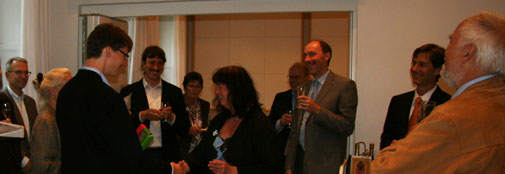Congratulations to David Balslev-Clausen

Dorthe Dahl-Jensen congratulates David Balslev-Clausen with his PhD degree.
Congratulations to David Balslev-Clausen from Centre for Ice and Climate, who succesfully defended his PhD Thesis Thursday, 22 September 2011.
End October 2011 David Balslev-Clausens thesis will be available here - meanwhile you can read the abstract here below.
Application of cavity ring down spectroscopy to isotopic bio- geo- & climate-science
&
The development of a Mid-IR CRDS analyzer for continuous measurements of N2O isotopomers.
This thesis conducts several explorations in applying sensitive optical spectroscopy methods to isotopic bio-geo-chemical and climate sciences.
A new mid-infrared cavity ring down spectrometer was successfully built. The analyzer measures the abundance of 14N15N16O and 15N14N16O relative to 14N14N16O as well as the concentration of N2O . The precision in d-values has been demonstrated to reach below 0.5‰ for both isotopomers. The analyzer can help elucidating microbial N2O dynamics in terrestrial ecosystems, perform monitoring of the atmosphere or to study climate history stored in ice cores air bubbles. Application to each of these fields is addressed in the presented thesis. The analyzer is easy to use, performs real time − continuous measurements and is a prototype for a coming product at Picarro Inc.
Another frontier work was on the application of CRDS, to measure Carbon-13 isotopic composition of rocks. Such measurements were made using a novel instrument from Picarro Inc. where CO2 from a ash combustion oven is send into an isotopic CO2 cavity ring-down spectrometer. Powdered rock samples containing kerogen or graphite were successfully analyzed by this method and it was found that rocks containing more than 0.5% TOC provides effective combustion and sufficient yield of CO2 to obtain analytical precision of the Carbon 13/12 ratio. It was found that 1 mg of carbon correspond to a CO2 concentration of 3000 ppm in the laser spectrometer. Measurements of USGS-24 graphite standards showed that the best precision was obtained for 1 mg to 2.5 mg of Carbon providing a precision of 0.05h in d13C. Successful inter comparison measurements with the mass spectrometric method, was made on samples straddling the SPICE isotopic excursion in a Cambrian Alum shale stratigraphic section.
Opponents: Jim White and Harro Meyer
